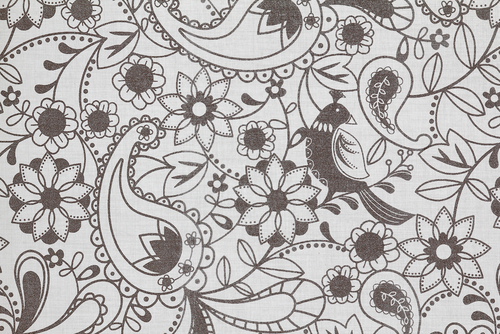Textile printing is the art of applying colour to a fabric to achieve a desired pattern or design. The longevity of the design is dependent on the dye job, whether it is bonded with the fabric to resist multiple washings or use, or merely printed in a digital format for short run items. Textile printing has some of the same processes as dyeing but the whole item is not submerged in dye, it is done part by part, colour by colour like a highly advanced, more technical paint by number project.
In printing, first a method of colour application is selected (See below: Methods of Printing.) and the colour is placed on the material. The dye used is a thicker solution than with other dye processes to ensure the colour from one area does not bleed into another, causing errors in pattern. Traditional textile printing is done is one of four ways.
1. Direct Printing: colorants containing dyes, thickeners, and mordants (a solution used to set the dye) are printed directly on the material in a desired deign.
2. Mordant Printing: where the colour sticks only where the mordant was applied.
3. Resist Dyeing: A process where wax is applied to fabric and the dye applied soaks into everywhere the wax is not.
4. Discharge Printing: Where a bleaching solution is used to removed areas of colour from a previously dyed fabric.
Now direct printing is the most widely used style in the modern world, but take a look at some of these fascinating techniques.
Methods of Printing
- Hand Block Printing: This method uses a carved wood block with the added details of copper or brass strips designed to create the smaller, finer details in a block pattern. When the block is finally prepared, it is pressed like a stamp into the colour, set on the cloth, and then impressed upon the fabric the additional pressure of a wooden mallet. This process is repeated until the pattern is completed. This is a slow, yet artistic process that requires attention to detail and a lot of patience!
- Perrotine Printing: This method uses a machine to complete block printing. It was introduced to cover a greater area, in less time, with reduced effort. Each block is assigned to a colour with a number of tools that help apply the required colour where its destined. This method works best for mass production, compared to the hand block for unique pieces.
- Engraved Copperplate Printing: This process founded in the UK by Thomas Bell used engraved plates installed in presses, dipped in dyes, and were then applied to fabric. This was used for letterpress type and quickly became obsolete when the problems of patterns not lining up were solved by the same creator with his introduction of Roller Printing.
- Roller Printing: This process allowed for 2-6 colours to be printed all at once with the great advantage of reproducibility, ensuring the colours, patterns, and joints lined up with little fault. This process was quick, efficient, and required less man power.
- Stencil Printing:This ancient art has been practiced for years in both Japan and parts of Europe. A pattern is cut out from paper or metal, the uncut part preventing colour from transfer. The stencil is then laid on fabric and dye can be applied, allowing the cut out areas to receive the colour applied.
- Screen Printing: This process, divided into two distinct methods of rotary screen and flat screen printing, is one of the most widely used today. A screen is created using a piece of mesh stretched over a frame. A stencil is created blocking off what image will be printed on the fabric. The result is a negative image of the screen as the ink is dragged across the screen using a squeegee to press it through the mesh and imprint on the fabric.
- Digital Textile Printing (Direct Garment Printing): is the process of using inkjet technology for direct printing on fabric from an inkjet printer. It uses a water-based ink (dye-sublimation or disperse direct ink) to print on manmade textiles such as Polyester, Spandex, Lycra or blends. Often this technique is used for business promotion, mass quantity pieces, or unique one of kind personal requests. It can be used for single pieces, or high volume short, mid, or long run production. This is the principle alternative to Screen Printing.
Jean R Velasquez is born in 1979. She works in Murray state university and graduated from there itself. She loves her family than anything and her favourite hobby is textile printing and home decoration. She is keener about latest trends and technology in fashion industry and tries to follow those in her works.

